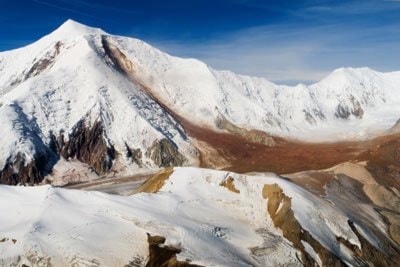Eating their lunches, everybody else had their backs to Mount Steele but Andy Williams had a great view of Canada’s fifth tallest mountain just as a large chunk of it fell away.
“I turned around and said, ‘Chaps, something’s going on and it’s time to start running,’” said Williams in an interview. “We were actually quite far, and nobody took my suggestion seriously.”
He was working alongside University of British Columbia glaciology professor Gary Clarke on July 22, the day of the landslide on north face of the 5,067-metre tall mountain.
“This is his last year. He’s retiring. Gary thought it was a message from the gods,” said Williams.
“The end had come, but let’s not go there,” he laughed.
What Williams and the glacier researcher witnessed was only the first of two massive landslides on Mount Steele.
Both happened within two days.
A seismic signal generated by the second slide was picked up world wide, according to the Yukon Geological Survey.
Snow and rubble rained down Mount Steele at first, said Williams, who was sitting about 10 kilometres away.
“At the time I was looking for somewhere to run,” he joked.
The researchers were actually quite a distance away on an adjacent glacier and quite safe, but there was still a lot of debris boiling up over a ridge in front of the group.
A bush pilot and mechanic based in Silver City, Williams has flown over the area for several decades and witnessed chunks of ice and snowfall from the north face of Mount Logan.
“If this happened in Pakistan or something this would have killed thousands of people in a village, said Williams. “It would have been a big story, but this is a remote part of the world.”
On July 24, the second landslide, one of the largest ever in Canada, rushed down Mount Steele at an estimated speed of 250 kilometres per hour.
Researchers won’t know the size or speed of the first slide, since the second one covered most of the evidence, said Payna Lipovsky, a surficial geologist with the Yukon Geological Survey.
Lipovsky visited the site herself just a couple days ago.
“It’s hard to get a sense of the scale of the mountain,” she said. “You see this huge chunk missing from the north face. When you realize that face is over two kilometres tall, it’s pretty powerful.
“There’s not too many places in the world you get faces that tall.”
Researchers from University of Waterloo and Simon Fraser will be heading back out to the site in the near future to study the landslide and the geological survey has been flooded with e-mails by researchers around the world.
Revisiting the site will allow researchers to determine the cause of the landslide, how much debris fell and at what speeds, but the whole picture of what happened won’t be known for another year or two.
Currently, it is hard to estimate the depth of the area from which the landslide fell.
The debris fell well across the glacier at the bottom of Mount Steele and covers a two-kilometre wide distance as well.
Now insulated, the glacier could be affected by the debris covering much of its surface, said Lipovsky.
“It doesn’t allow it to melt as much,” she said. “It could affect the rate that it moves.”
Reddish rocks and dust travelled an estimated seven kilometres from the top of the slide to the toe of the debris, added Lipovsky.
Any ice that fell was probably pulverized as it travelled down the mountain.
“All that’s remaining now is this mass of reddish-looking rocks. It’s all crumbled and there’s a lot of dust covering the ridge in front of the glacier,” said Lipovsky.
There’s a rush to visit the site immediately because it is such a rare event and is still fresh.
“The more information gathered as soon as possible after the slide, the better,” said Lipovsky.
Researchers could identify where future slides could happen in similar terrain, and learn how it occurred and how it travelled.
Landslides of the scale are usually triggered by earthquakes, but not in this case and while it is too early to know the exact cause of the landslide, there are some theories.
The face of Mount Steele is covered by a thick glacier, which could have played a role in the landslide, said Lipovsky.
“There could be climate effects affecting the glacier,” she said. “The glacier could be thinning. It could also be permafrost degradation at the base of the ice within the rock, which could break apart the rock.”
Or, she added, it could be the repeated low-level earthquakes happening over the last millennium that are weakening the bedrock.
Whatever the cause, researchers are pretty sure of one thing: Mount Steele is still highly unstable and could be ready for another landslide.
